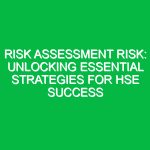Introduction
In today’s rapidly evolving world, the concept of risk assessment risk assessment has become a cornerstone in the Health, Safety, and Environment (HSE) domain. Risk assessment is the systematic process of evaluating potential risks that may be involved in a projected activity or undertaking. It plays a crucial role in identifying hazards, assessing risks, and implementing controls to mitigate them. As organizations strive to create safer workplaces and minimize environmental impacts, understanding and executing effective risk assessments is more critical than ever.
Imagine walking into a construction site where heavy machinery operates alongside workers. The potential for accidents looms large. Now picture a comprehensive risk assessment process that identifies these hazards, evaluates the risks, and establishes safety protocols. This proactive approach not only protects employees but also fosters a culture of safety that permeates the organization. Throughout this article, we will explore the essential components of risk assessment risk assessment within the HSE context, offering insights and strategies that lead to success.
Key Aspects of Risk Assessment in HSE
Understanding Risks and Hazards
At the heart of risk assessment risk assessment lies the distinction between risks and hazards. A hazard is anything that can cause harm, such as chemicals, machines, or even workplace violence. In contrast, risk is the likelihood of the hazard causing harm and the severity of that harm. For instance, consider a laboratory where hazardous chemicals are used. The chemicals are the hazards; the risk involves evaluating the chances of exposure and the potential health implications.
Risk Assessment Process
The risk assessment process typically follows a structured approach, which includes:
- Identification of Hazards: This step involves recognizing potential sources of harm. In the earlier example of the laboratory, this might include identifying all chemicals and equipment used.
- Risk Analysis: Once hazards are identified, the next step is to analyze the risks associated with each hazard. This involves considering the likelihood of an incident and the severity of its consequences.
- Risk Evaluation: In this phase, organizations prioritize risks based on their analysis. This helps in determining which risks require immediate attention and which can be monitored over time.
- Control Measures Implementation: After evaluating risks, organizations must implement appropriate control measures to mitigate identified risks. This could involve engineering controls, administrative policies, or personal protective equipment.
- Monitoring and Review: Risk assessment is not a one-time task. Regular monitoring and review of the risk assessment process ensure that it remains effective and up-to-date.
Benefits of Effective Risk Assessment
Implementing a robust risk assessment process offers numerous benefits:
- Enhanced Safety: By identifying and mitigating risks, organizations create safer working environments, reducing the likelihood of accidents.
- Regulatory Compliance: Many industries are governed by strict regulations that mandate risk assessments. Compliance not only avoids legal repercussions but also enhances organizational credibility.
- Cost Reduction: Effective risk management can lead to significant cost savings by preventing accidents and associated liabilities.
- Improved Employee Morale: A culture that prioritizes safety fosters a sense of responsibility and care among employees, boosting morale and productivity.
Best Practices in Risk Assessment
Involve Employees
One of the most effective strategies for successful risk assessment is involving employees in the process. Those who work on the front lines often have invaluable insights into potential hazards. For example, during a risk assessment in a manufacturing plant, involving machine operators can lead to the identification of overlooked risks, such as ergonomic hazards.
Utilize Technology
Technology can significantly enhance the risk assessment process. Tools like risk assessment software can streamline documentation, track hazards, and facilitate communication. Moreover, data analytics can help in identifying patterns and trends, leading to more informed decision-making.
Continuous Training and Awareness
Regular training sessions and workshops on risk assessment principles are crucial. They ensure that all employees understand the importance of identifying and reporting hazards. A case study from a chemical processing company revealed that after implementing regular safety training, the number of reported near-misses decreased significantly, highlighting the effectiveness of continuous education.
Potential Hazards and Safety Considerations
Common Workplace Hazards
Understanding common workplace hazards is vital for effective risk assessment. Some prevalent hazards include:
- Chemical Hazards: Exposure to toxic substances can lead to serious health issues. Proper labeling and Material Safety Data Sheets (MSDS) are essential.
- Physical Hazards: Slips, trips, and falls account for a significant number of workplace injuries. Regular inspection of work areas can help mitigate these risks.
- Biological Hazards: In industries like healthcare, exposure to pathogens poses a significant risk. Ensuring proper hygiene and personal protective equipment is critical.
Regulations and Standards
Legal Framework for Risk Assessment
The importance of risk assessment is underscored by various regulations and standards that govern workplace safety. In the United States, the Occupational Safety and Health Administration (OSHA) sets forth guidelines that require employers to perform risk assessments and implement necessary safety measures. Similarly, in the European Union, the Framework Directive on Safety and Health at Work mandates risk assessments as a fundamental requirement for organizations.
These regulations not only protect employees but also provide a framework for organizations to follow, ensuring systematic risk management. Compliance with such regulations can help organizations avoid hefty fines and enhance their operational reputation.
Conclusion
Risk assessment risk assessment is not merely a regulatory checkbox; it is a vital strategy for promoting health, safety, and environmental sustainability. By thoroughly identifying and evaluating risks, organizations can create safer workplaces that protect employees and the environment. Moreover, fostering a culture of safety through employee involvement, technological integration, and continuous training can lead to significant improvements in organizational performance.
As the world continues to face new challenges, the importance of effective risk assessment will only grow. Embracing this proactive approach not only safeguards lives but also contributes to the overall success of an organization. Let us commit to making risk assessment an integral part of our operational strategies, unlocking the potential for a safer, healthier future.


